Stress Monitoring of Concrete via Uniaxial Piezoelectric Sensor
Abstract
:1. Introduction
2. Fundamental Principle of Piezoelectric Stress Sensor
2.1. Basic Theory of Piezoelectric Materials
2.2. Measuring Principle of Piezoelectric Stress Sensor
3. Development and External Calibration Performance Analysis of Uniaxial Piezoelectric Sensor
4. Concrete Stress Monitoring Method Based on the Uniaxial Piezoelectric Sensor
5. Application and Verification of Monitoring Method
5.1. Monitoring the Stress Whole Process in Concrete Specimen
5.2. Monitoring the RC Column’s Confining Stress
6. Conclusions
- (1)
- The proposed sensor had high linearity between applied stress and output charge and responded well to an external load. In addition, the loading rate and load pattern did not affect the sensor’s sensitivity, and its work performance was stable.
- (2)
- The charge curve obtained by the embedded concrete sensor was consistent with the overall trend of the concrete surface strain curve, without hysteresis, and the two were positively proportioned in the concrete’s elastic stage. The strain correction factor obtained by the sensor embedded in concrete was 1.07.
- (3)
- The stress curve derived by the suggested method was in good agreement with the average stress curve of the concrete specimen before it reached maximum stress, and the average error between them was less than 6.3%. The error between the concrete strength increase factor of the proposed technique and Mander’s confinement theory was about 1.0%, which verifies the reliability of the proposed method. Future work will investigate the confinement mechanism of steel-confined concrete based on the proposed method.
Author Contributions
Funding
Institutional Review Board Statement
Informed Consent Statement
Data Availability Statement
Conflicts of Interest
References
- Khan, M.K.I.; Lee, C.K.; Zhang, Y.X.; Rana, M.M. Compressive behaviour of ECC confined concrete partially encased steel composite columns using high strength steel. Constr. Build. Mater. 2020, 265, 120783. [Google Scholar] [CrossRef]
- Wu, B.; Jian, S.; Zhao, X. Structural behavior of steel-concrete partially encased composite columns containing demolished concrete lumps under axial compression. Eng. Struct. 2019, 197, 109383. [Google Scholar] [CrossRef]
- Yan, X.; Zhao, Y.; Lin, S.; Zhang, H. Confining stress path-based compressive strength model of axially compressed circular concrete-filled double-skin steel tubular short columns. Thin Wall Struct. 2021, 165, 107949. [Google Scholar] [CrossRef]
- Smolana, A.; Klemczak, B.; Azenha, M.; Schlicke, D. Experiences and analysis of the construction process of mass foundation slabs aimed at reducing the risk of early age cracks. J. Build. Eng. 2021, 44, 102947. [Google Scholar] [CrossRef]
- Xue, S.; Geng, Y.; Li, X.; Li, J.; Song, Y. Stress development and crack monitoring of massive concrete walls with embedded air-cooling pipes. J. Adv. Concr. Technol. 2021, 19, 999–1015. [Google Scholar] [CrossRef]
- Kim, C.; Park, H.; Chung, K.; Choi, I. Eccentric axial load capacity of high-strength steel-concrete composite columns of various sectional shapes. J. Struct. Eng. 2014, 140, 4013091. [Google Scholar] [CrossRef]
- Kim, T.U.; Le, H.V.; Park, J.W.; Eock, S.K.; Jang, Y.; Kim, D.J. Development of a smart concrete block with an eccentric load sensing capacity. Constr. Build. Mater. 2021, 306, 124881. [Google Scholar] [CrossRef]
- Salehian, H.; Barros, J.A.O. Prediction of the load carrying capacity of elevated steel fibre reinforced concrete slabs. Compos. Struct. 2017, 170, 169–191. [Google Scholar] [CrossRef] [Green Version]
- Alharthi, Y.M.; Emara, M.; Elamary, A.S.; Sharaky, I.A. Flexural response and load capacity of reinforced concrete beams strengthened with reinforced mortar layer. Eng. Struct. 2021, 245, 112884. [Google Scholar] [CrossRef]
- Sun, L.; Ma, Q.; Han, F.; Liu, Z.; Li, J.; Wang, P.; Zhao, H.; Sun, J. Experimental investigation on axial compression behavior of steel reinforced concrete columns with welded stirrups. Eng. Struct. 2020, 208, 109924. [Google Scholar] [CrossRef]
- Lai, B.; Liew, J.Y.R.; Xiong, M. Experimental study on high strength concrete encased steel composite short columns. Constr. Build. Mater. 2019, 228, 116640. [Google Scholar] [CrossRef]
- Zhao, X.; Wen, F.; Chan, T.; Cao, S. Theoretical stress-strain model for concrete in steel-reinforced concrete columns. J. Struct. Eng. 2019, 145, 4019009. [Google Scholar] [CrossRef]
- Neild, S.A.; Williams, M.S.; McFadden, P.D. Development of a vibrating wire strain gauge for measuring small strains in concrete beams. Strain 2005, 41, 3–9. [Google Scholar] [CrossRef]
- Wang, H.; Dai, J.; Wang, X. Improved temperature compensation of fiber Bragg grating-based sensors applied to structures under different loading conditions. Opt. Fiber Technol. 2021, 63, 102506. [Google Scholar] [CrossRef]
- Wang, H.; Dai, J. Strain transfer analysis of fiber Bragg grating sensor assembled composite structures subjected to thermal loading. Compos. Part B Eng. 2019, 162, 303–313. [Google Scholar] [CrossRef]
- Han, B.; Ou, J. Embedded piezoresistive cement-based stress/strain sensor. Sens. Actuators A Phys. 2007, 138, 294–298. [Google Scholar] [CrossRef]
- Ou, J.; Han, B. Piezoresistive cement-based strain sensors and self-sensing concrete components. J. Intel. Mat. Syst. Struct. 2009, 20, 329–336. [Google Scholar]
- Sun, M.; Liew, R.J.Y.; Zhang, M.; Li, W. Development of cement-based strain sensor for health monitoring of ultra high strength concrete. Constr. Build. Mater. 2014, 65, 630–637. [Google Scholar] [CrossRef]
- Dong, B.; Liu, Y.; Qin, L.; Wang, Y.; Fang, Y.; Xing, F.; Chen, X. In situ stress monitoring of the concrete beam under static loading with cement-based piezoelectric sensors. Nondestruct. Test Eva 2015, 30, 312–326. [Google Scholar] [CrossRef]
- Liu, Q.; Gao, R.; Tam, V.W.Y.; Li, W.; Xiao, J. Strain monitoring for a bending concrete beam by using piezoresistive cement-based sensors. Constr. Build. Mater. 2018, 167, 338–347. [Google Scholar] [CrossRef]
- Lezgy-Nazargah, M.; Saeidi-Aminabadi, S.; Yousefzadeh, M.A. Design and fabrication of a new fiber-cement-piezoelectric composite sensor for measurement of inner stress in concrete structures. Arch. Civ. Mech. Eng. 2019, 19, 405–416. [Google Scholar] [CrossRef]
- Song, G.; Gu, H.; Mo, Y.L.; Hsu, T.; Dhonde, H.; Zhu, R.R.H. Health monitoring of a concrete structure using piezoceramic materials. In Proceedings of the Smart Structures and Materials 2005: Sensors and Smart Structures Technologies for Civil, Mechanical, and Aerospace Systems, San Diego, CA, USA, 17 May 2005; pp. 108–119. [Google Scholar] [CrossRef]
- Song, G.; Olmi, C.; Gu, H. An overheight vehicle–bridge collision monitoring system using piezoelectric transducers. Smart Mater. Struct. 2007, 16, 462–468. [Google Scholar] [CrossRef]
- Li, Z.; Yang, X.; Li, Z. Application of cement-based piezoelectric sensors for monitoring traffic flows. J. Transp. Eng. 2006, 132, 565–573. [Google Scholar] [CrossRef]
- Yang, X.; Li, Z.; Ding, Y.; Zongjin, L. Test on sensor effect of cement matrix piezoelectric composite. Trans. Tianjin Univ. 2005, 11, 133–136. [Google Scholar]
- Liu, Y. Experimental Study on Dynamic Stress Monitoring with Embedded Piezoceramic for Concrete Structures; Hunan University: Changsha, China, 2013. (In Chinese) [Google Scholar]
- Hou, S.; Yu, Y.; Zhang, H.B.; Mao, X.Q.; Ou, J.P. A SA-based wireless seismic stress monitoring system for concrete structures. Int. J. Distrib. Sens. Netw. 2013, 9, 978313. [Google Scholar] [CrossRef] [Green Version]
- Hou, S.; Zhang, H.B.; Ou, J.P. A PZT-based smart aggregate for compressive seismic stress monitoring. Smart Mater. Struct. 2012, 21, 105035. [Google Scholar] [CrossRef]
- Hou, S.; Zhang, H.B.; Ou, J.P. A PZT-based smart aggregate for seismic shear stress monitoring. Smart Mater. Struct. 2013, 22, 65012. [Google Scholar] [CrossRef]
- Zhang, H.; Hou, S.; Ou, J. Smart aggregate-based seismic stress monitoring system using a specially designed charge amplifier. J. Intel. Mat. Syst. Str. 2016, 27, 418–426. [Google Scholar] [CrossRef]
- Hou, S.; Zeng, C.; Zhang, H.; Ou, J. Monitoring interstory drift in buildings under seismic loading using MEMS inclinometers. Constr. Build. Mater. 2018, 185, 453–467. [Google Scholar] [CrossRef]
- Du, G.; Zhang, J.; Zhang, J.; Song, G. Experimental study on stress monitoring of sand-filled steel tube during impact using piezoceramic smart aggregates. Sensors 2017, 17, 1930. [Google Scholar] [CrossRef] [Green Version]
- Zhang, H.; Hou, S.; Ou, J. Feasibility of SA–based concrete seismic stress monitoring for high-strength concrete. J. Intel. Mat. Syst. Str. 2017, 28, 2428–2436. [Google Scholar] [CrossRef]
- Zhang, H.; Hou, S.; Ou, J. Smart aggregates for monitoring stress in structural lightweight concrete. Measurement 2018, 122, 257–263. [Google Scholar] [CrossRef]
- Brockmann, T.H. Theory of Adaptive Fiber Composites from Piezoelectric Material Behavior to Dynamics of Rotating Structures; Springer: Dordrecht, The Netherlands, 2009. [Google Scholar]
- Du, Y.; Sun, B.; Zhang, G. Smart Materials and Structural Health Monitoring; Huazhong University of Science and Technology Press: Wuhan, China, 2011. (In Chinese) [Google Scholar]
- Shuang, H.; Zhang, H.; Sheng, Y. Piezoceramic-based smart aggregates for seismic stress monitoring of RC building. Int. Soc. Opt. Photonics 2011, 7981, 79812N. [Google Scholar]
- Zeng, H.; Yu, S. The calculation of matching error of rock-soil pressure transducer. Rock Soil Mech. 2001, 22, 99–105. (In Chinese) [Google Scholar]
- GB_50010-2010; Code for Design of Concrete Structures; Ministry of Housing and Urban-Rural Development of the People’s Republic of China: Beijing, China, 2015. (In Chinese)
- Mander, J.B.; Priestley, M.J.; Park, R. Theoretical stress-strain model for confined concrete. J. Struct. Eng. 1988, 114, 1804–1826. [Google Scholar] [CrossRef] [Green Version]
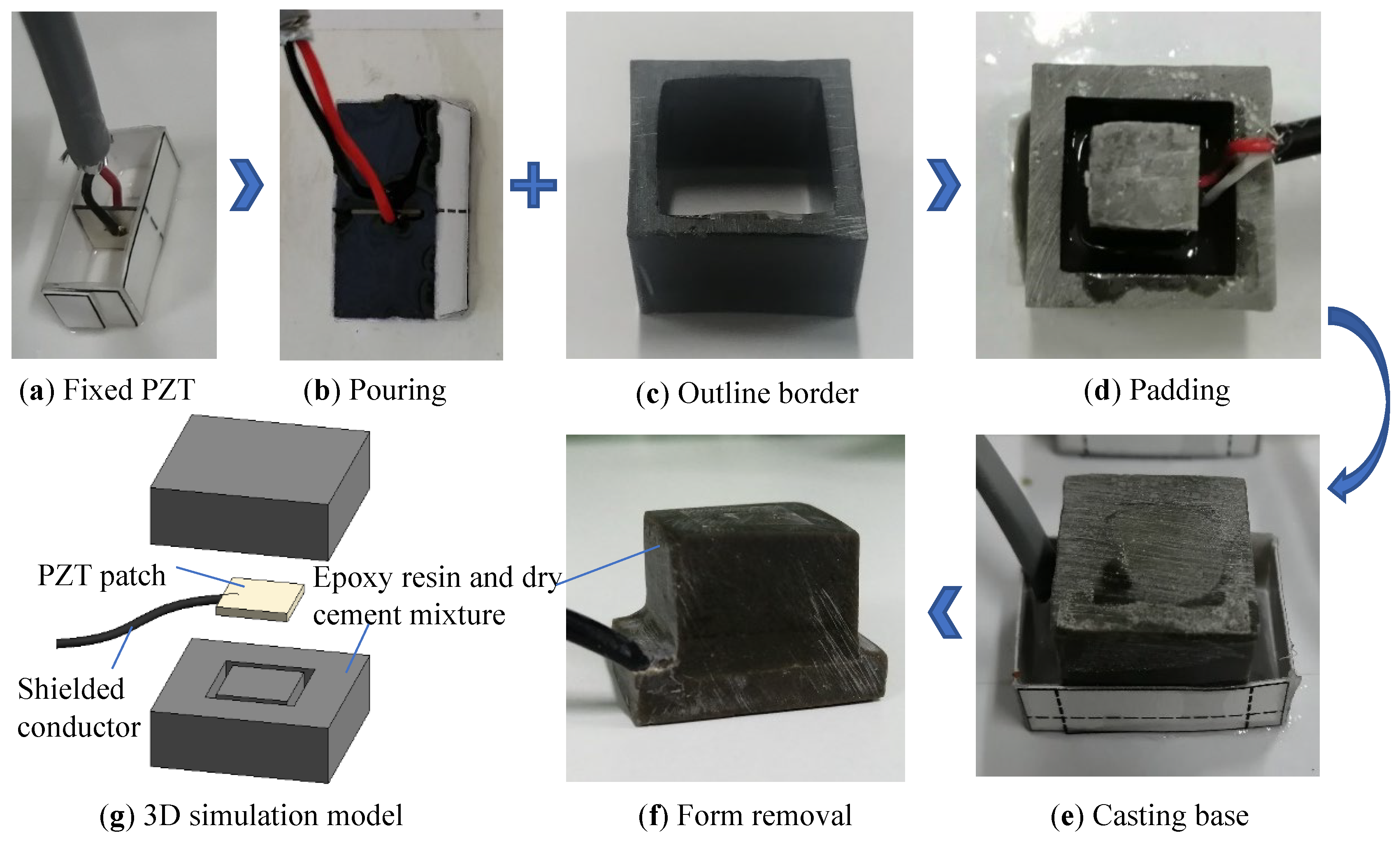
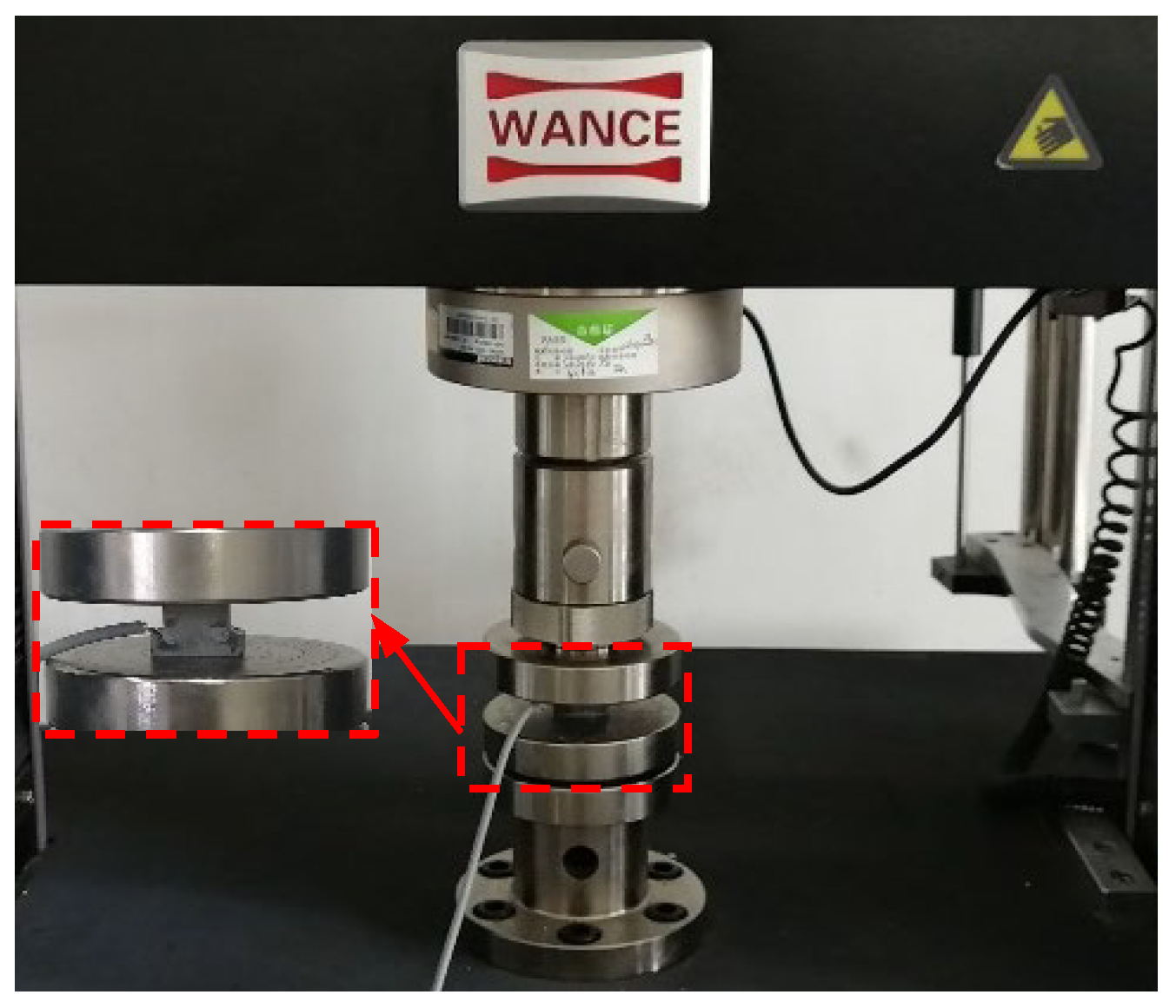
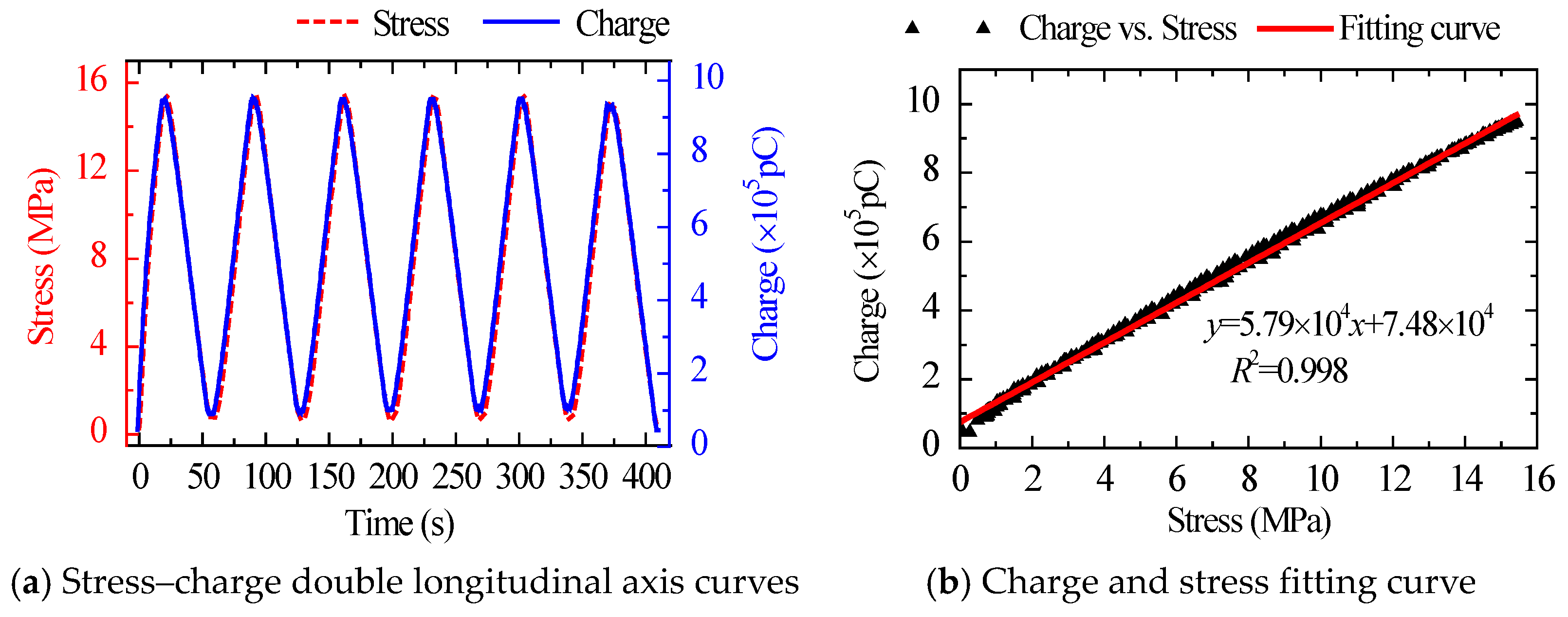

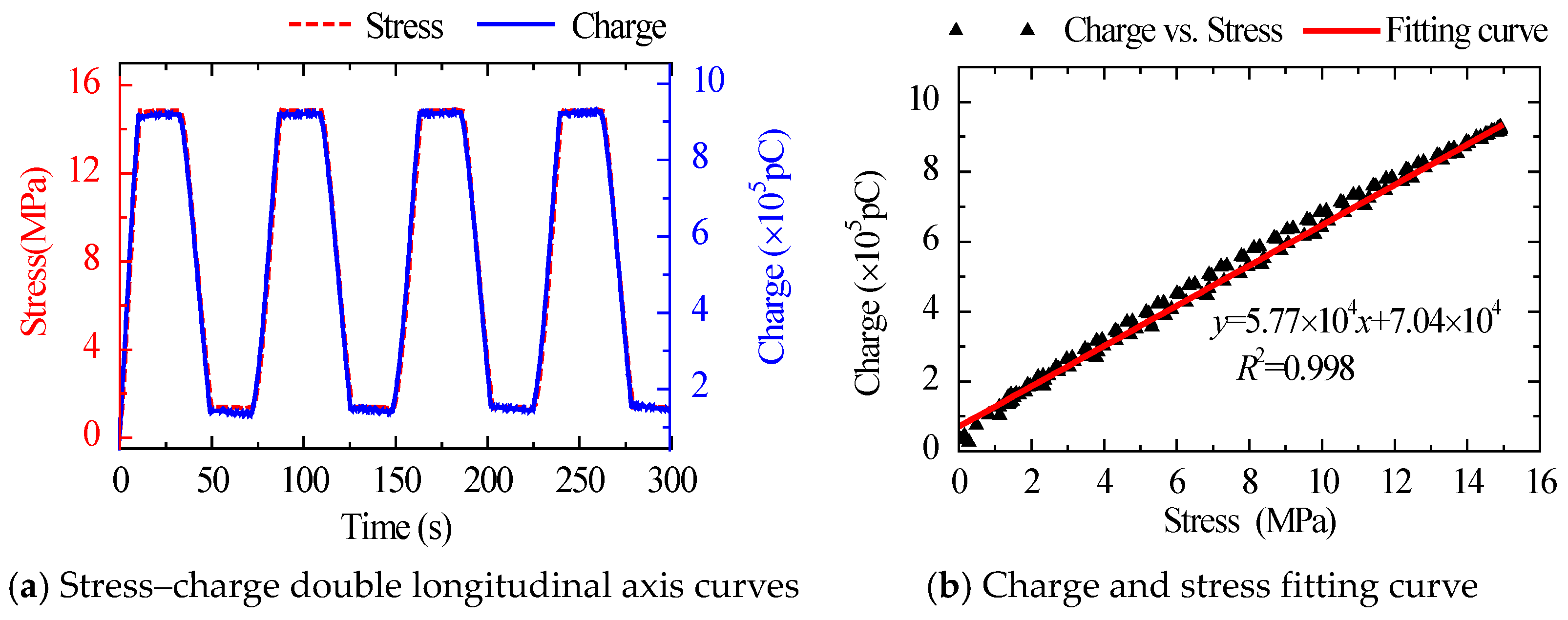

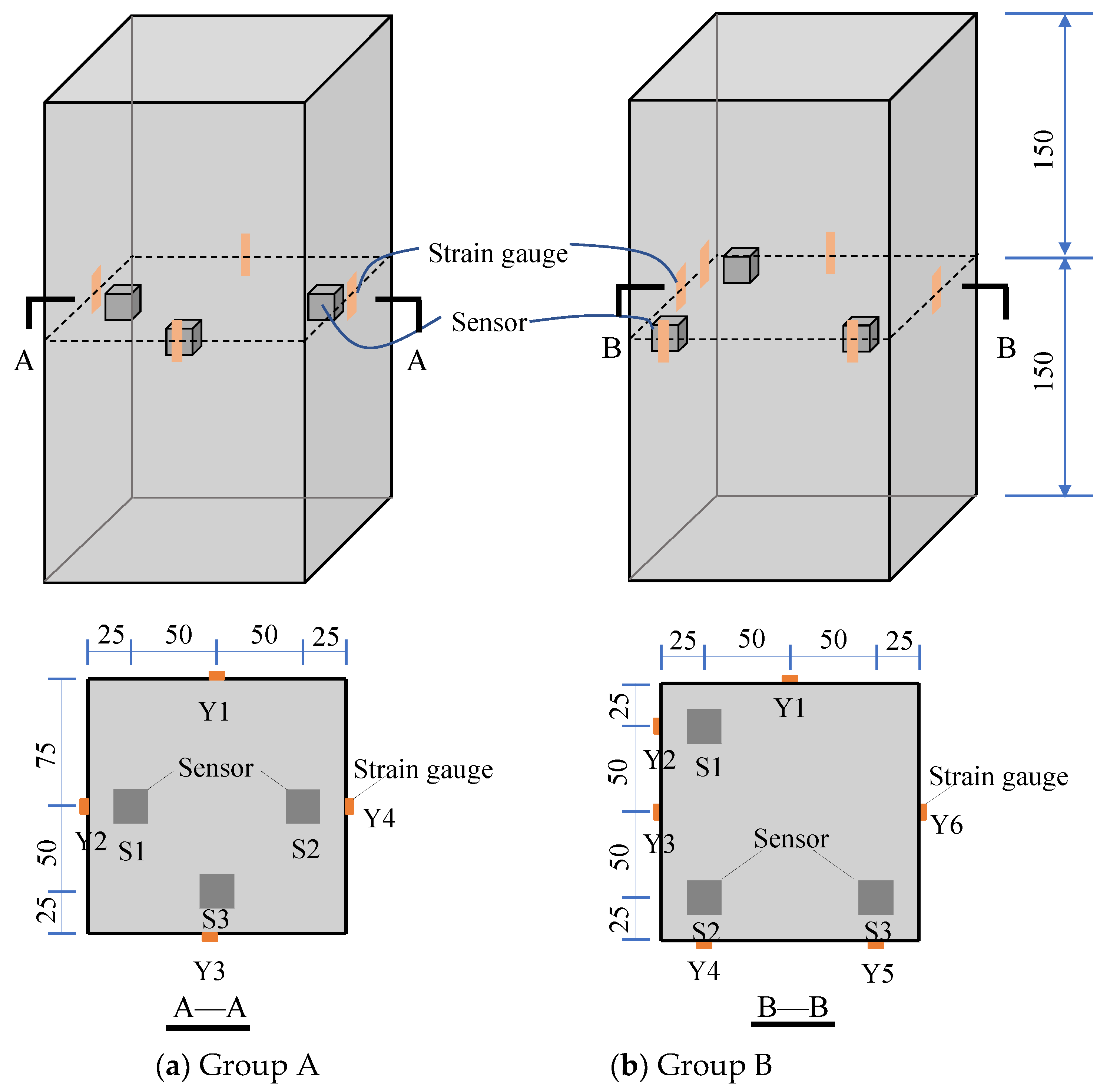


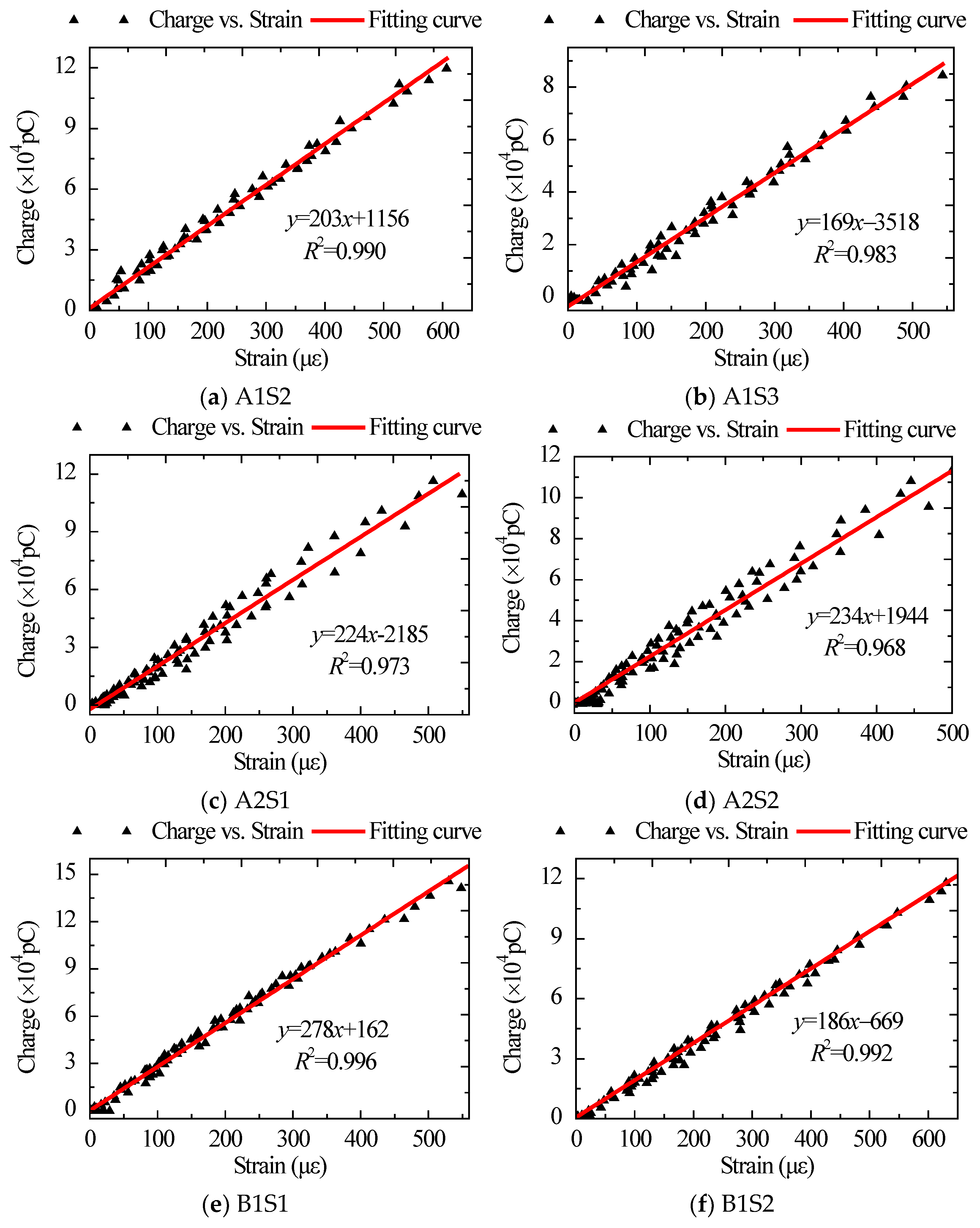

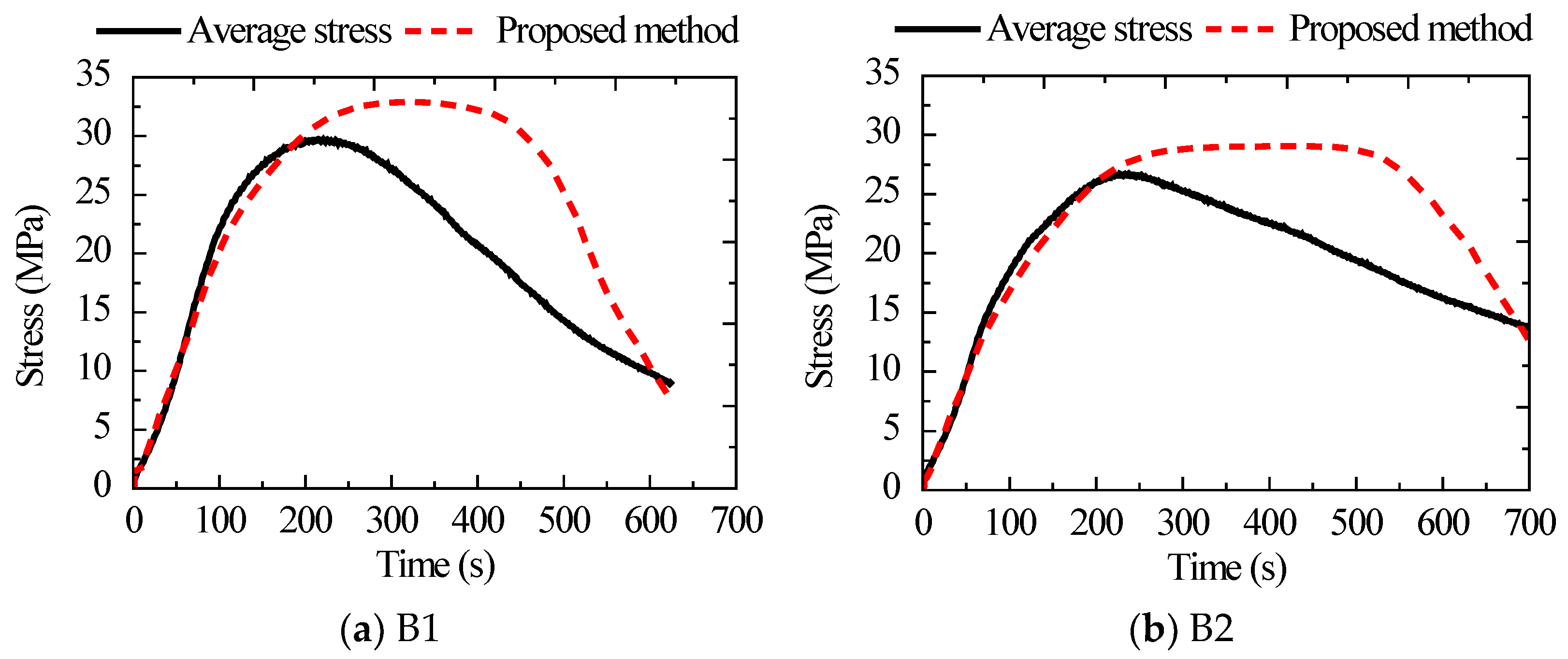
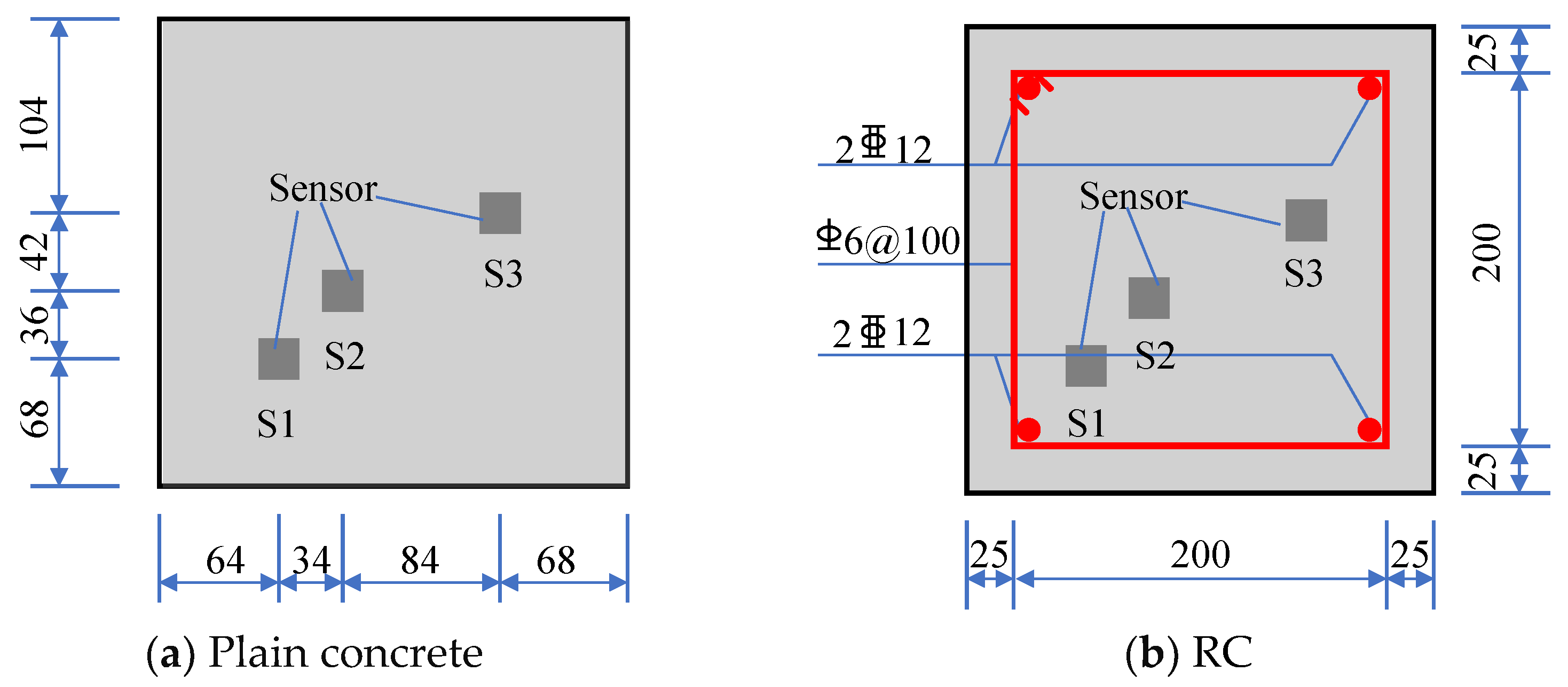
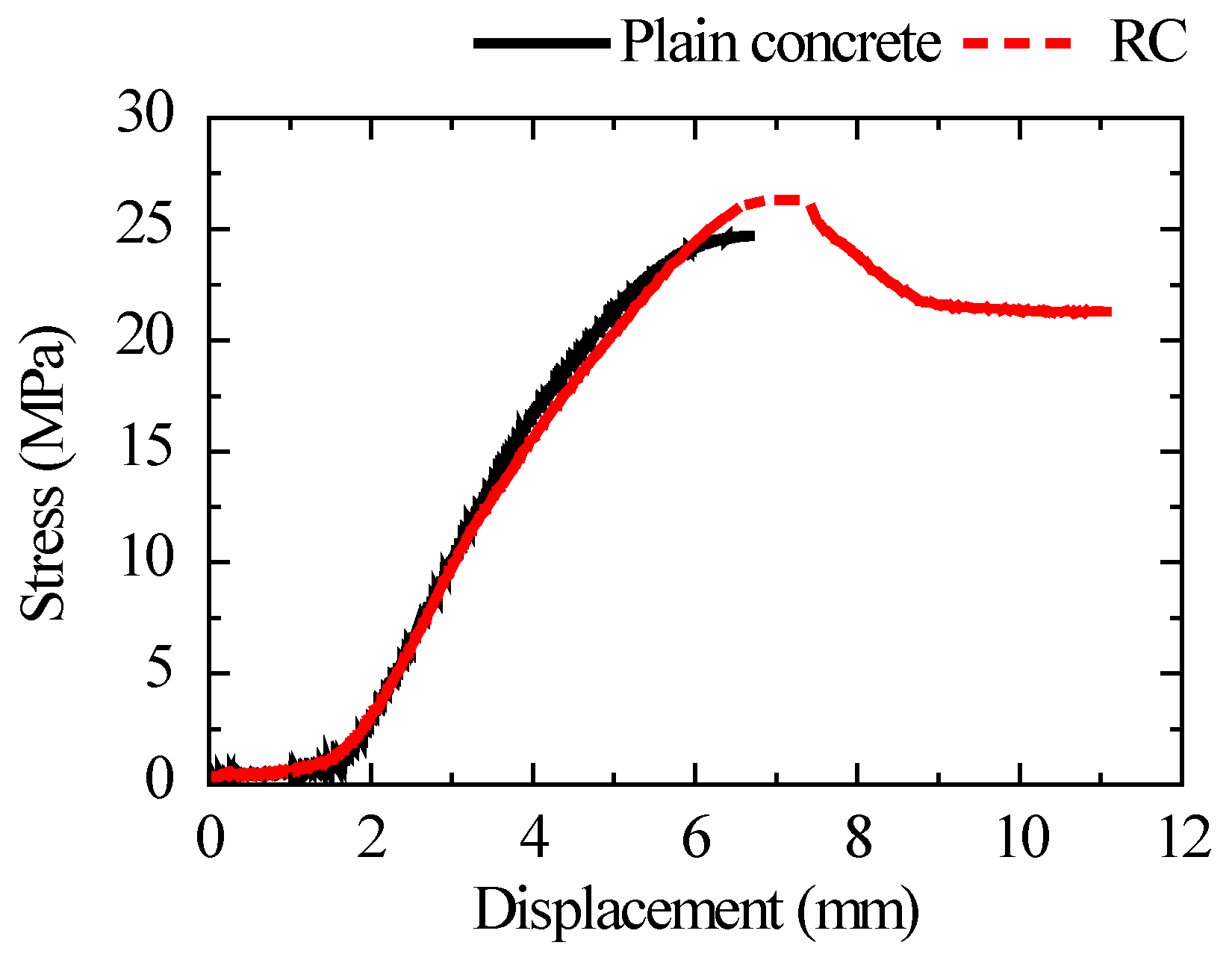
| Performance Category | Property Values | Performance Category | Property Values | Performance Category | Property Values |
|---|---|---|---|---|---|
| Size (mm) | 8 × 8 × 0.5 | Elastic constants Y11E (N/m2) | 1.2 × 1010 | Piezoelectric strain constant d33 (C/N) | 232 × 10−12 |
| Density (kg/m3) | 7600 | Elastic constants Y33E (N/m2) | 7.0 × 1010 | Piezoelectric strain constant d31 (C/N) | −90 × 10−12 |
| Relative permittivity εr | 1400 | Elastic constants Y55E (N/m2) | 29.4 × 1010 | Piezoelectric strain constant d15 (C/N) | 378 × 10−12 |
| Loading Cases | Load Patterns | Stress Amplitude Range (MPa) | Loading Rate (MPa/s) |
|---|---|---|---|
| Case 1 | Triangular repetition | 0~16 | 0.5 |
| Case 2 | Triangular repetition | 0~16 | 0.8 |
| Case 3 | Trapezoid repetition | 0~16 | 0.8 |
| Case 4 | Stepwise repetition | 0~20 | 0.8 |
| Group | Specimen Number | Sensor Number | Sensitivity (pC/MPa) | Group | Specimen Number | Sensor Number | Sensitivity (pC/MPa) |
|---|---|---|---|---|---|---|---|
| Group A | A1 | S1 | 62,574 | Group B | B1 | S1 | 77,160 |
| S2 | 66,082 | S2 | 66,304 | ||||
| S3 | 54,497 | S3 | 62,275 | ||||
| A2 | S1 | 74,314 | B2 | S1 | 72,842 | ||
| S2 | 87,604 | S2 | 71,858 | ||||
| S3 | 57,015 | S3 | 82,699 |
| Sensor Number | Sensor Number | ||||||
|---|---|---|---|---|---|---|---|
| A1S1 | 182 | 202 | 1.11 | B1S1 | 216 | 278 | 1.24 |
| A1S2 | 192 | 203 | 1.05 | B1S2 | 255 | 186 | 0.96 |
| A1S3 | 159 | 169 | 1.06 | B1S3 | 166 | 181 | 1.09 |
| A2S1 | 216 | 224 | 1.04 | B2S1 | 212 | 256 | 1.21 |
| A2S2 | 255 | 234 | 0.92 | B2S2 | 209 | 246 | 1.18 |
| A2S3 | 166 | 174 | 1.05 | B2S3 | 241 | 263 | 1.09 |
| Average value of correction factor | 1.07 | ||||||
| Standard deviation of correction factor | 0.092 | ||||||
| Variation coefficient of correction factor | 0.086 | ||||||
| Specimen | Sensor Number | Sensitivity (pC/MPa) | Specimen | Sensor Number | Sensitivity (pC/MPa) |
|---|---|---|---|---|---|
| Plain concrete | S1 | 58,153 | RC | S1 | 59,988 |
| S2 | 36,139 | S2 | 38,324 | ||
| S3 | 47,228 | S3 | 47,351 |
Publisher’s Note: MDPI stays neutral with regard to jurisdictional claims in published maps and institutional affiliations. |
© 2022 by the authors. Licensee MDPI, Basel, Switzerland. This article is an open access article distributed under the terms and conditions of the Creative Commons Attribution (CC BY) license (https://creativecommons.org/licenses/by/4.0/).
Share and Cite
Wu, C.; Xiang, H.; Jiang, S.; Ma, S. Stress Monitoring of Concrete via Uniaxial Piezoelectric Sensor. Sensors 2022, 22, 4041. https://doi.org/10.3390/s22114041
Wu C, Xiang H, Jiang S, Ma S. Stress Monitoring of Concrete via Uniaxial Piezoelectric Sensor. Sensors. 2022; 22(11):4041. https://doi.org/10.3390/s22114041
Chicago/Turabian StyleWu, Chen, Hong Xiang, Shaofei Jiang, and Shenglan Ma. 2022. "Stress Monitoring of Concrete via Uniaxial Piezoelectric Sensor" Sensors 22, no. 11: 4041. https://doi.org/10.3390/s22114041






